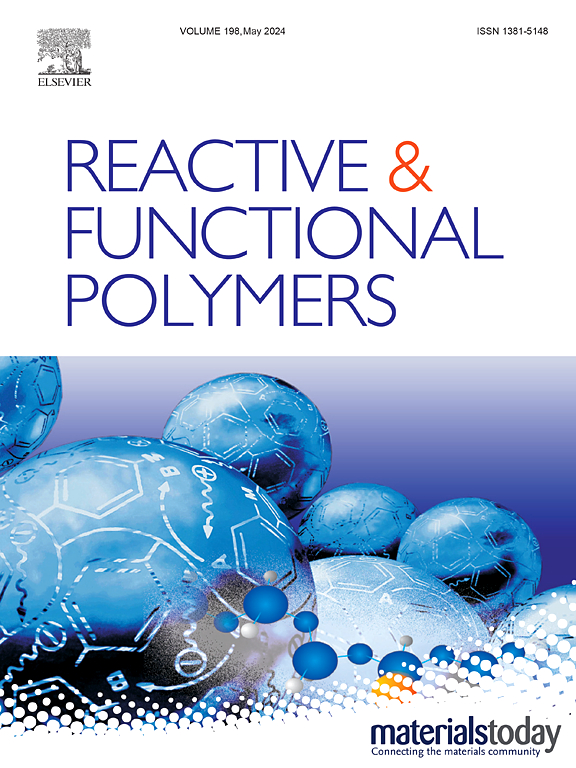Eu-modified poly (L-lactic acid) microspheres with enhanced crystallinity and stability by incorporation of rare-earth ions interacting with polymer chains via temperature-tuned emulsification
IF 5.1
3区 工程技术
Q1 CHEMISTRY, APPLIED
引用次数: 0
Abstract
Incorporation of lanthanide ions into polymers via rare-earth organic complexes poses the issue of the interaction between the polymer matrix and lanthanide compounds, which can significantly influence both the rare-earth functional properties and the structural features of the matrix. This work investigates the synthesis of europium-containing poly (L-lactic acid) (PLLA) microspheres through an oil-in-water emulsion of PLLA and europium (III) acetylacetonate hydrate dissolved in dichloromethane and water containing poly (vinyl alcohol). The synthesis was conducted at various temperature – from 20 °C to 80 °C, including conditions above the PLLA glass transition. Results from X-ray diffraction and Raman scattering give evidence of higher crystallinity in Eu-modified PLLA microspheres than in undoped PLLA, while differential scanning calorimetry indicates that Eu addition hinders PLLA chain mobility with a resulting decrease in PLLA melt crystallization ability. Insights into the incorporation mechanisms of Eu3+ in the microspheres were provided by photoluminescence, scanning-electron-microscopy, micro-computed-tomography, X-ray fluorescence, and infrared spectroscopy. The analysis shows that Eu3+ complexes enter the polymer structure by interacting with PLLA chains, modifying the local environment of the lanthanide ions. These findings finally provide a new basis for designing tailored synthesis methods for specific applications.

稀土离子通过温度调节乳化作用与聚合物链相互作用,提高了eu修饰聚l -乳酸微球的结晶度和稳定性
镧系离子通过稀土有机配合物掺入聚合物中提出了聚合物基体与镧系化合物相互作用的问题,这将显著影响稀土的功能性质和基体的结构特征。本文研究了在二氯甲烷和含聚乙烯醇的水中,将聚乳酸(PLLA)和铕(III)乙酰丙酮酸水合物(europium (III) acetylacetonate hydrate)溶于水的油包水乳液合成含铕聚乳酸(PLLA)微球。合成在不同的温度下进行-从20°C到80°C,包括高于PLLA玻璃化转变的条件。x射线衍射和拉曼散射结果表明,Eu修饰的PLLA微球的结晶度高于未掺杂的PLLA,而差示扫描量热法表明,Eu的加入阻碍了PLLA链的迁移,导致PLLA熔体结晶能力下降。通过光致发光、扫描电子显微镜、微计算机断层扫描、x射线荧光和红外光谱分析,深入了解了Eu3+在微球中的掺入机制。分析表明,Eu3+配合物通过与PLLA链的相互作用进入聚合物结构,改变了镧系离子的局部环境。这些发现最终为设计适合特定应用的合成方法提供了新的基础。
本文章由计算机程序翻译,如有差异,请以英文原文为准。
求助全文
约1分钟内获得全文
求助全文
来源期刊

Reactive & Functional Polymers
工程技术-高分子科学
CiteScore
8.90
自引率
5.90%
发文量
259
审稿时长
27 days
期刊介绍:
Reactive & Functional Polymers provides a forum to disseminate original ideas, concepts and developments in the science and technology of polymers with functional groups, which impart specific chemical reactivity or physical, chemical, structural, biological, and pharmacological functionality. The scope covers organic polymers, acting for instance as reagents, catalysts, templates, ion-exchangers, selective sorbents, chelating or antimicrobial agents, drug carriers, sensors, membranes, and hydrogels. This also includes reactive cross-linkable prepolymers and high-performance thermosetting polymers, natural or degradable polymers, conducting polymers, and porous polymers.
Original research articles must contain thorough molecular and material characterization data on synthesis of the above polymers in combination with their applications. Applications include but are not limited to catalysis, water or effluent treatment, separations and recovery, electronics and information storage, energy conversion, encapsulation, or adhesion.
 求助内容:
求助内容: 应助结果提醒方式:
应助结果提醒方式:


